Chapter 01
Everyone who likes yakitori,A craftsman who devotes himself to yakitori,
And to young people aiming for this path.
I would like to say to you all, “This skewer is something that will only be made once in a lifetime.”
I am always facing the chicken, the charcoal, and myself.
All of this leads to the encounters with our customers. Yakitori is a living example of this country’s culinary traditions.
There is a taste that brings smiles to people, in Japan or the wider world. I want to devote my life to mastering the charm of a single skewer.
We want to preserve and nurture the traditions of Japanese food culture and pass them on to the future. To achieve this, we must pursue the essence of yakitori, evolve it to a higher level, and perfect it as a single dish.
The deliciousness of the food, the atmosphere of the restaurant, and the atmosphere of the customers
I believe it is necessary to create a place where deliciousness, the atmosphere of the restaurant, and the atmosphere of the customers become a trinity. But I am still lacking in this area.
This is why yakitori is so fascinating.
This is a summary of my thoughts and experiences with yakitori. I hope that I can share it with all of you and that it will be of some help to you. I hope that it serves as an opportunity to deepen the bonds and expand the possibilities for people involved in the food industry.
Chapter 02
Encounter with yakitori.
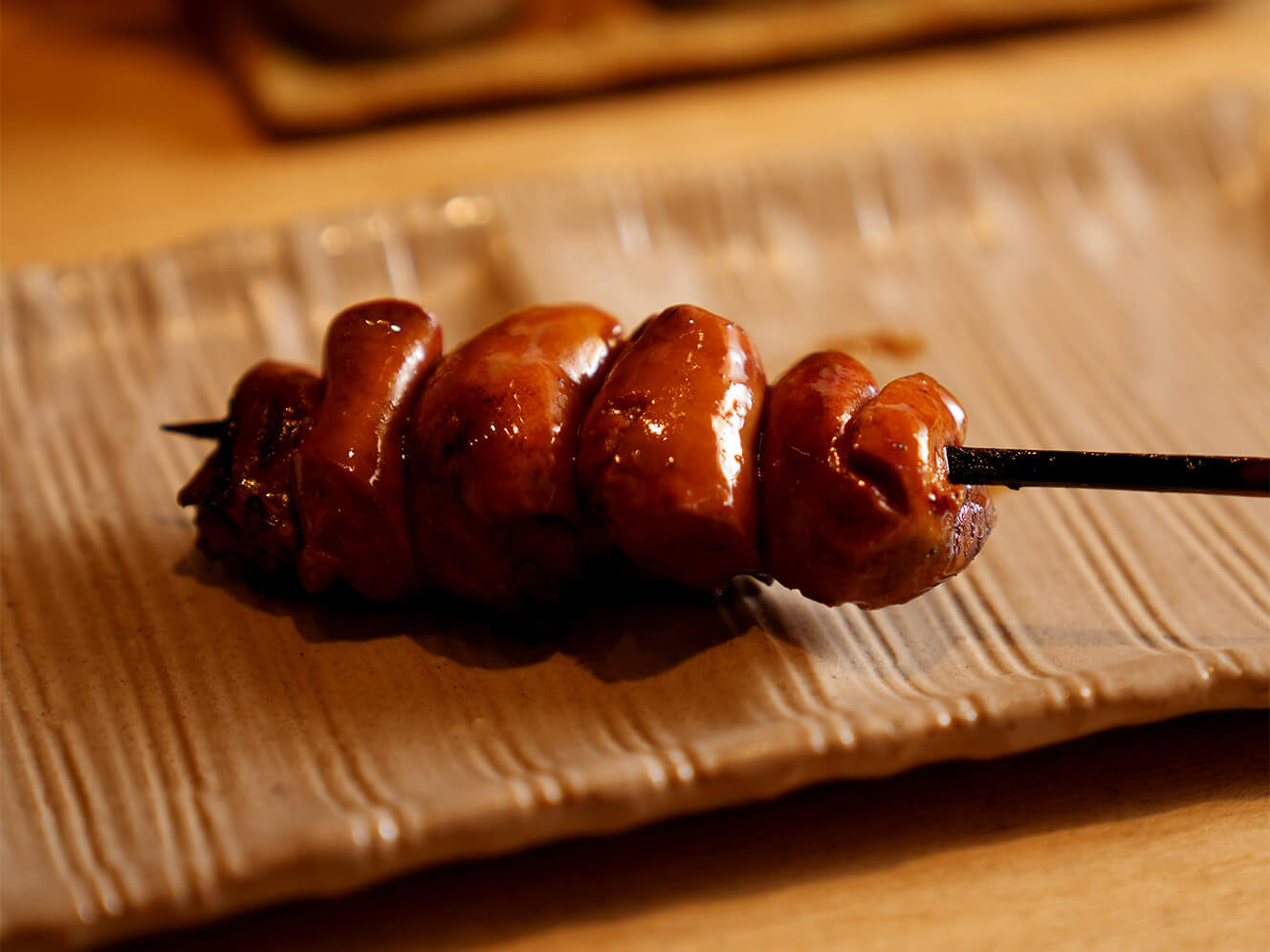
When I was in elementary school about 40 years ago, in downtown Edogawa-ku, Tokyo, I walked to and from school passing through a bustling shopping street. When I got hungry after playing tag or playing with my friends on the way home, the smoke from yakitori wafted in from somewhere and I could smell the sweet, yet spicy aroma. It was like eating a meal all by itself…when I turned around, it was that smell that hit my brain and stomach. The price was affordable even for a child, and on Saturdays when I only had classes in the morning, I went to that yakitori shop to buy some.
My father used to frequent izakayas back then, and sometimes he would take me along as well. The restaurant was lined with menus of yakitori. Drinking orange juice, I was excited again, thinking, “This is yakitori,” and I ordered some rice and devoured the meat in bliss. It filled me up and became the origin of “an ideal dinner” in my mind. I don’t cook yakitori at home, and the smell, space, and atmosphere that I experienced as a child on the streets of shopping arcades and in izakaya (Japanese style pubs) still have that “uplifting sensation” burned into me.
When I was in college, a friend’s parents happened to own a yakitori restaurant in Shizuoka. While visiting and helping out at the restaurant during summer vacation, I suddenly thought about the future. I was in my early twenties, struggling with what I had envisioned when I was a teenager and life not quite going the way I wanted it to. I was going to get a job and go out into the real world, but what was I really aiming for? Perhaps my timing was right, as I thought, “Even if I fail, I’d be happy to be involved in the yakitori business that I love.” That was the beginning of my desire to do yakitori and to open a restaurant someday.
Even if I wanted to “do” yakitori, I did not know what to do. I thought I first needed to go out into society and gain experience, so I got a job as a sales representative for a temporary staffing agency. I ate at more than 100 yakitori restaurants in the limited time I had after work and on weekends, and felt anew that “yakitori is profound and full of life.” In an age without Internet or SNS, I would go to restaurants that were said to be famous with a magazine in hand. Finally, I came across “Toriyoshi” in Nakameguro. I was overwhelmed by the work and atmosphere; I had never seen before anything like it. I was shocked from the bottom of my heart that such a restaurant existed. I was 27 years old when I found out that “Toriyoshi” was looking for a new employee.
Chapter 03
The pillar of my apprenticeship.
I honestly thought I was underestimating yakitori in the beginning. I had only a superficial view of things, and I mistakenly thought that it would not take much time to become a full-fledged yakitori chef. I thought I would be able to satisfy my customers by creating the right atmosphere and serving them the good food. I had never even used a knife before, but when I went to “Toriyoshi” thinking I would be allowed to grill right away, my naive thinking was instantly and fundamentally shattered.
For the first year, I was not even allowed to touch the chicken, relegated to chores and cleaning. Many people quit, but I never thought about quitting. As I was gradually taught the true nature of the job and began to understand why I was assigned only chores and cleaning, I learned firsthand that “yakitori may look simple, but it really is something profound.” It was four years after I joined the company that I was actually allowed to grill. I started rather late because I wasn’t very good at it. The more experienced chefs were doing more and more, and it was frustrating to be surpassed by them.
Because “Toriyoshi” is a yakitori restaurant that operates like a sushi restaurant, everything is exposed to the public, including your hands, facial expressions, and demeanor, so there are no excuses. If I get emotional or make even the slightest unpleasant face, the customer will immediately feel it. I thought it would be difficult to get customers to come back if I treated them like this, even though they had paid for their time, so I spent my time looking in the mirror and practicing my facial expressions, making the most of my many mistakes. Looking back, I think that my master recognized that I had finally learned the importance of the ingredients, how to handle charcoal, how to look at things, and how to treat customers, little by little.
From then on, I spent my days thinking and concentrating only on what I could do to ensure that my customers would enjoy my baking. One fundamental pillar that made helped me grow during my seven years of training was never forgetting to “always face yourself and think objectively.” This is especially so in the “Toriyoshi” environment, where every action is strictly monitored. I believe it was because I never forgot to “always face myself and think objectively.
Chapter 04
Exhaust
all five senses,
and enjoy
all five senses.
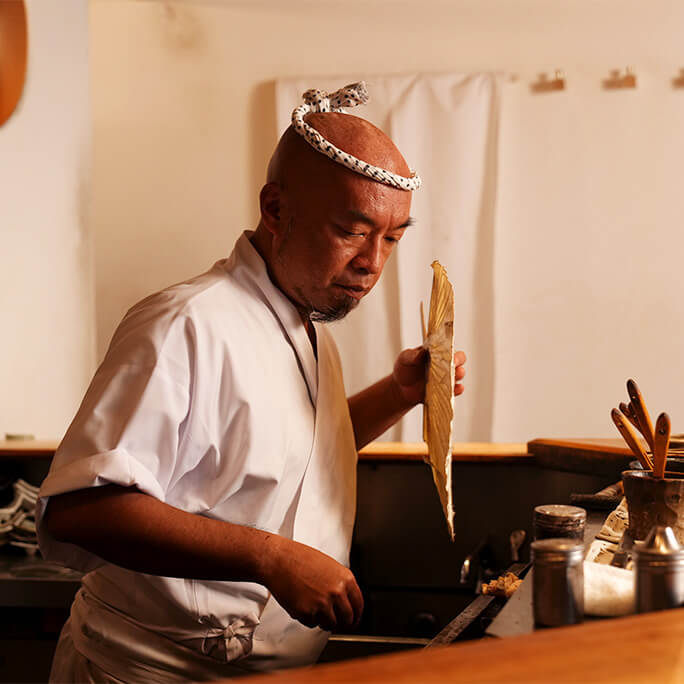
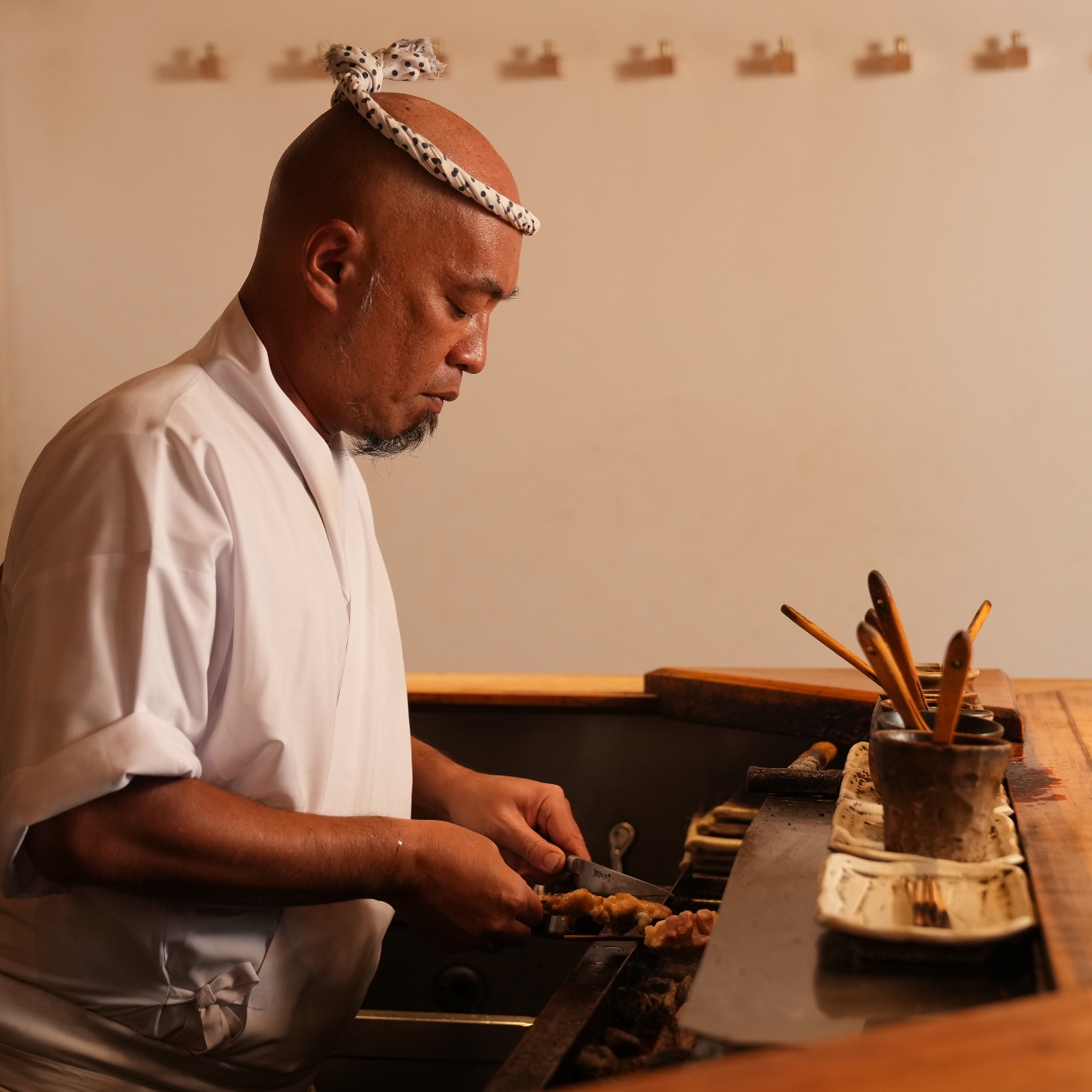
“Sight,” which makes food look delicious before you eat it. “Hearing” the sounds of charcoal crackling and burning, and the sound of an uchiwa fan being used to fan the charcoal. “Smell,” allowing you to enjoy the aroma of charcoal, meat, and sauce. “Touch,” such as the different textures of the skewers and the texture of the meat in your mouth. “Taste,” when enjoying the deliciousness of the food. I want to be an artisan who satisfies all five senses when it comes to yakitori. When we interact with people, we unconsciously perceive their facial expressions, breathing, and presence through our five senses. The abstract sensation of “somehow delicious” or “somehow comfortable,” The abstract sense of “somehow delicious” or “comfortable,”—the abstract nature of this “somehow,” as well as the atmosphere of the restaurant and the customer service are all connected to the customer’s five senses. Therefore, the customer is the star of the show. In order to ensure a pleasant dining experience, we must act as behind-the-scenes supporters and let our five senses act as sensors.
For example, when two customers come to a restaurant, there are various relationships between them, and we must immediately sense what kind of relationship and position they are in, what they want to eat, and which one of them should be served first. Otherwise, we cannot make our customers forget about time altogether and enjoy their time with us. When I thought about how to evolve yakitori, which everyone is already familiar with, into something more valuable, I inevitably came to think that the process of customers eating yakitori and leaving is condensed into my practice as a yakitori artisan.
Without that, you cannot even come close to the feelings of the other person. The same applies when it comes to materials. If you think about the feelings of the material, you will know if you should use it quickly or if you should leave it a little longer. No two pieces of charcoal are the same, so when you tap it, you can hear if it sounds dull or sharp, and you can also understand if it is clogged up and how much moisture is in it. We need to be able to “feel” from the perspective of the materials we use in order to know what is going on or what makes them different. It is absolutely important to discern such with an honest and sensitive mind. Because yakitori is a simple dish, the ability to delve deeply into the essence of the dish makes a big difference in technique, and this is naturally perceived by customers.
Even today, yakitori is a dish that is difficult to make at home. In this digital world, the nostalgia and uniqueness of charcoal grilling, which is still engraved in the DNA of Japanese people, is unchangingly precious, and I think it is interesting and great for both our customers and our craftsmen. Yakitori is something that can be enjoyed with all five senses. And I believe that the job of yakitori is also “a job to be faced with all five of your senses.”
Chapter 05
Yakitori chefs are athletes.
Every day, I purchase whole chickens, cut them myself, and grill them over a “close-hot high flame” using Kishu binchotan charcoal. Qualification is required to handle whole chickens, and it begins with understanding the condition of each chicken on that day. Binchotan is the best charcoal for yakitori because it can maintain a high flame, and the close fire quickly locks in the juices and flavor for a full roast. Each skewer has different characteristics, so it is necessary to grill them with an eye to their individuality, not in a self-centered way. The difference in technique is born from “continuity.” Other techniques include skewering, using different skewers for different parts of the meat, maintaining the heat, turning the skewers, fanning the skewers, preparing and using sauce and seasonings, and many other techniques that are necessary for preparing quality yakitori. However, we craftsmen who work with charcoal must be especially sensitive to “temperature” in order to produce a good grill.
In terms of temperature, it is also important to sense the “temperature of people. People are emotional creatures, and our customers often express their feelings of joy, anger, sadness, and pleasure. Whether they’re having fun, or frustrated, or lonely…I want to be sensitive to the temperature of people’s feelings in various situations. For example, even in the procedural order of preparing yakitori, it is important to be sensitive to the temperature of people. For example, it would not feel good if you made a mistake and serve a customer who arrived before the previous customer received their meal. If you are not examining at the situation at hand, you could not even sense things like this, so you must always be attentive and considerate. If you make a mistake, you can ease the customer’s mind by simply saying “I’m sorry” when they leave. It is important to feel the temperature of your guests, observe them, and learn to sense their physical and emotional distance before grilling yakitori.
In yakitori, there are many things to “face” before finishing a single skewer. You face the chicken, the producer, the parts, the charcoal, and yourself, and the ultimate culmination of all of these is facing the customer. Each of these confrontations is the charm of this profession. To achieve this, I have to be disciplined and earnestly face off against my materials and everything else, and I find this very rewarding.
The yakitori chef I am striving to become today is similar to a martial artist or athlete. I want people to see how I hone my “mind, technique, and body,” and how I compete seriously every moment of the day. I believe that the process begins and ends with gratitude (“rei”). I want to entertain our guests and bring them joy and excitement. For me, this job may be something like “The Way of Yakitori,” a way of mastering a uniquely Japanese art that is similar to martial arts, tea ceremony, flower arrangement, and so on. In fact, my restaurant has become a kind of dojo where my apprentices train themselves.
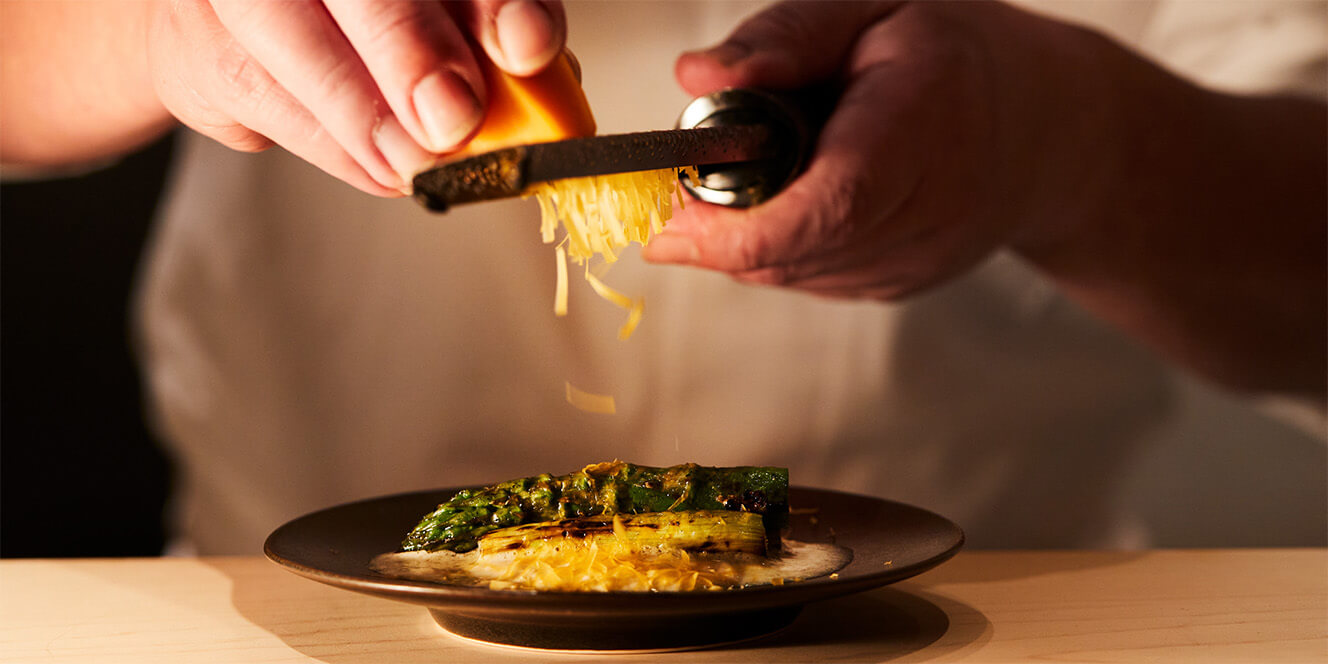
Chapter 06
A craftsman is only a craftsman
when they enhance their resourcefulness
and life experience.
I like EXILE and LDH’s live performances. I resonate with the stance of “I am the performer, and the main actor is the audience. I always tell the staff, “Imagine how the audience would feel if they were the performers.” At Torishiki, customers make reservations months in advance and look forward to the day of the show. Perhaps it is the same feeling as when you get a ticket for a concert you want to see and wait for the day of the concert… I think about the customers and what they expect from us, and I prepare myself well. If you don’t have the capacity to consider how others feel, you can’t really face the customer. Even if you go to a live concert the first time, you will not be moved to want to see it again or meet that person one more time. Even though our worlds are different, there are many things we can learn from entertainment.
The ability to perceive and respond to the customer’s needs is as important as or more important than the ability to cook. Good cooking cannot be done without first improving one’s “human ability,” which is the foundation of the cooking process. With different customers coming in every day, it may be a true live performance to instantly sense their personalities and relationships with their companions, and serve them skewers at the right time. Every skewer is different, and every customer is a once-in-a-lifetime encounter. Each skewer is different, and each customer has a unique encounter with us. In this serious competition, we must always sharpen our concentration and enhance our resourcefulness, the spirit of hospitality and consideration for others, which are important qualities that determine whether we can call ourselves yakitori chefs or not.
The starting point for improving one’s human resourcefulness is cleaning, chores, and greetings during training. It is surprising that people today are not able to do these things, often taking them for granted. I believe that in any company, even a person with an ideal academic background will not be able to move up the ladder if they have no heart, even if they were hired at first. People who continue to grow step by step and are sought after by others are those who can honestly listen to what others have to say. Therefore, we need to improve our hearts, which is skill now being lost overtime. Even when replying to someone, not looking them in the eye when you say something makes the reply a simple “operation”; if you look them in the eye and say it with your heart, they will understand. The “atmosphere” cannot be created unless everyone in the restaurant is aware of this, so we place great importance on this attitude as the most basic of basics.
Each customer is different. We have to carefully listen to the feelings of each and every one of them and take action. Without the resourcefulness to combine that ability with heart, we cannot provide value beyond what our customers can imagine. We secretly hope to become the “LDH of the yakitori world” so that no matter how many times our customers come back, they leave with a sense of excitement and happiness.
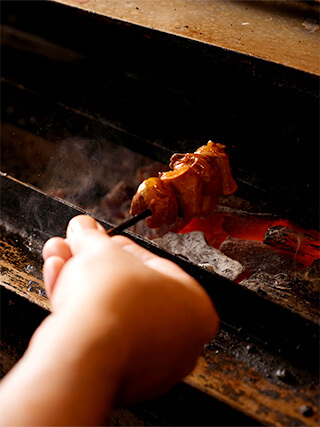
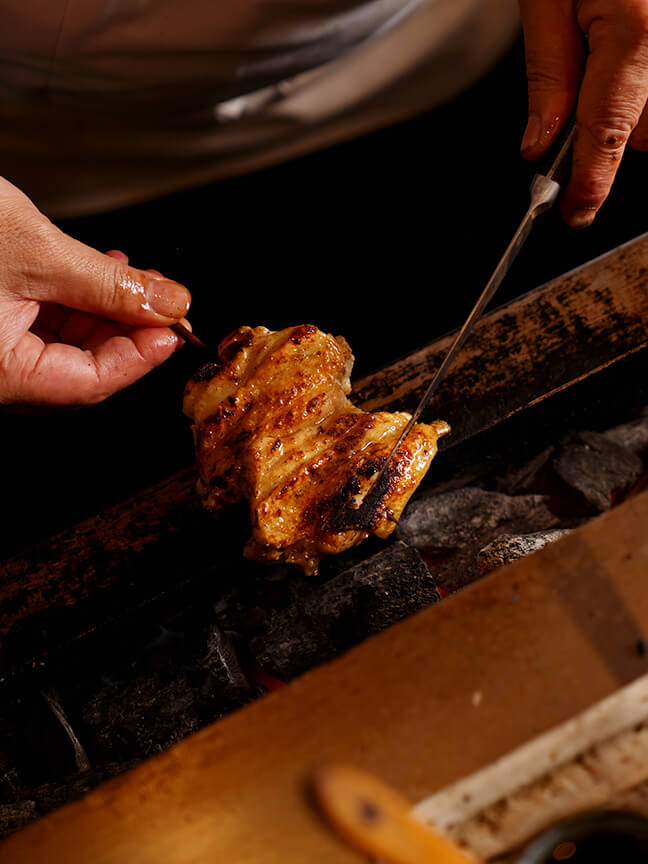
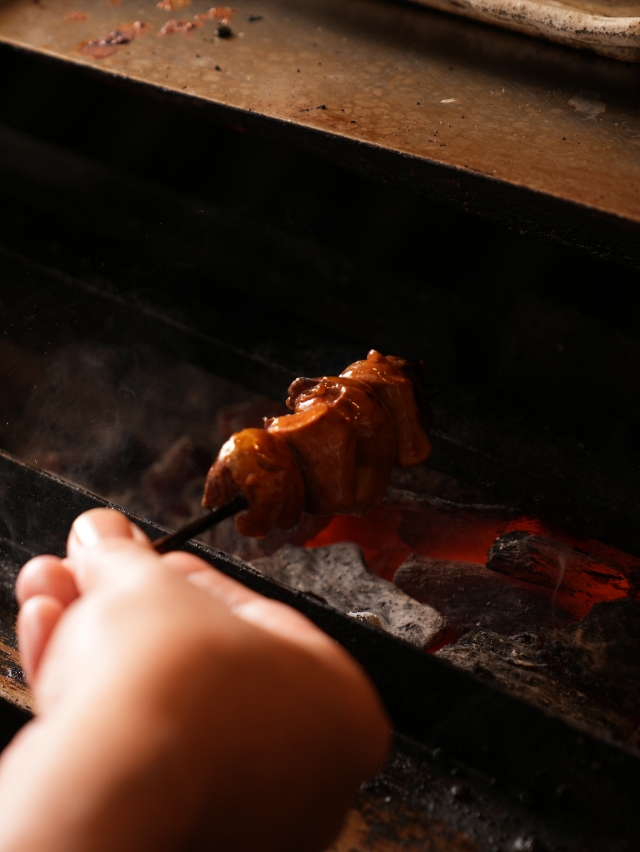
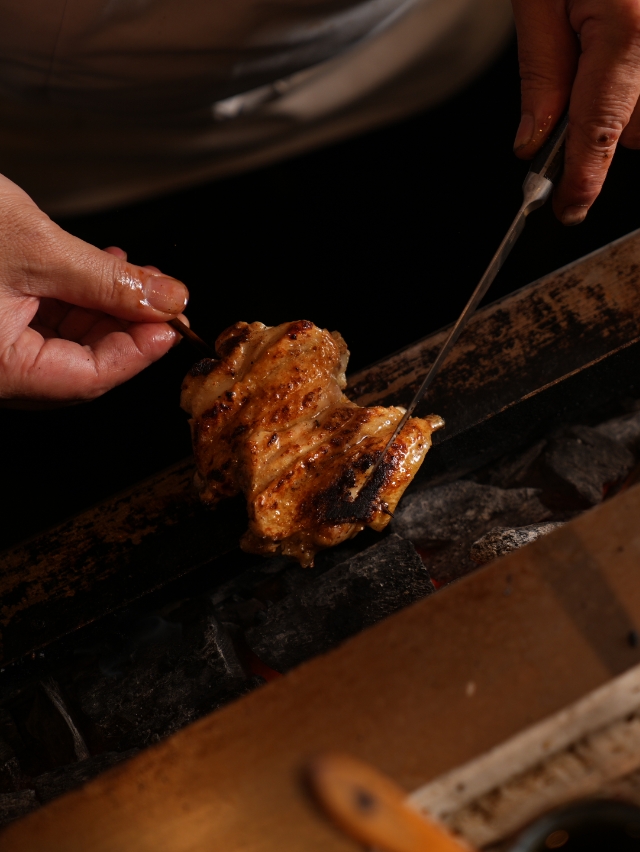
Chapter 07
Connecting traditional food culture
to the future.
Sushi and tempura have established themselves as part of Japan’s traditional food culture, but compared to them, yakitori is simple and familiar, so it is often taken lightly. There was a time when it was dismissed as “un-Japanese” food. However, when you think about it, this analog food that has survived to the present day, using traditional Japanese charcoal as the heat source, is a precious commodity. I have always thought that it could be called “one of Japan’s traditional food cultures.”
There are various occasions to enjoy yakitori, and what was once just a menu item at an izakaya has now diversified to include chain, speciality, and high-class restaurants. The reality is that even under such circumstances, yakitori has not yet reached the status of sushi or tempura, and one of the reasons for this is that there are not many artisans who can convey the “essence of yakitori.” I have a sense of mission, though selfish, that I must be a craftsman, and that I must be a bearer of the culture of yakitori so that I can become one of the benchmarks now that I have gained some recognition. To this end, I want to make yakitori a complete dish, and I want my customers to enjoy the seriousness of yakitori.
When I was in training, my master taught me to “not show yourself.” When you are young, you tend to want to express yourself, so this is difficult. I came to the conclusion that “not expressing myself is my way of expressing myself.” In the end, it is important to make customers feel that the yakitori is delicious and that they want to come back again, and if they remember that they want to eat that yakitori, that is ultimately how I am expressing myself. At first glance, customers may think I am someone who looks difficult to talk to, but when I smile at them, I make them feel touched. Although I might look intimidating, I am kind when I talk to them… I think that is how I stand (laughs).
What I am aiming for is just one example of what a yakitori restaurant should look like, but I want to make it a place where people who work there are rewarded for having a big goal and dream. My switch was flipped on when I opened “Torishiki” and started receiving requests from young people who wanted to train with me. As a seasoned artisan, I have a responsibility to continue growing and show my back to my apprentices so that they will be able to eat even after they go out on their own, feeling happy to have worked in a yakitori restaurant. If nobody protects and works to evolve the traditional methods of yakitori, it will not develop as a Japanese food culture. I would like to work together with you to nurture “artisans who connect traditions.”
Chapter 08
We want to surprise the world
with the vigor of artisans.
When we presented our yakitori overseas at an event in Spain, our audience thought it was so amazing that we received a standing ovation. At that time, I thought yakitori could become a facet of Japanese food culture that had a strong impact and could be accepted by more people. After talking with various foreign chefs, I realized that no one had yet attempted to spread authentic yakitori overseas. That is the reason why I wanted to convey this traditional Japanese food culture, and I rediscovered that Japanese artisans have a lot of potential.
Yakitori restaurants can now be found overseas, and poultry has the potential to be enjoyed by people all over the world without religious problems. However, there are only a few countries where it is customary to eat internal organs, and there aren’t many restaurants that offer a variety of parts. I use “Date” chicken myself, but many parts other than the large intestine can be eaten, each with a different texture and taste. It is possible to procure good chicken locally even in foreign countries, and there is a wide variety of chicken meat available. The chickens are free-range and their food is close to nature. They can eat when hungry and sleep when sleepy, so they are healthy and basically any kind of chicken can be used to make yakitori. I want to try convey the traditional way of “using every part with care,” which is unique to Japan, and I think there are great opportunities for foreign customers to discover this as well.
When I think first of handling the ingredients, using charcoal is definitely a good method, so I will stick to that. In Japan, charcoal is used in not only Japanese restaurants but also French and Italian restaurants. Furthermore, the use of charcoal and wood for cooking is gradually increasing around the world. I believe that the use of charcoal makes yakitori more enjoyable for all five senses, and that is why people around the world can feel “Japan” beyond words when they enjoy it. Combined with charcoal, skewers, fans, the aroma of soy sauce, and sake (wine also goes well with it, of course), I believe that yakitori can be accepted as a dish that is the sheer power of Japanese synthesis, rich in the “essence of traditional Japanese culture.”
I hope that artisans who continue the tradition of yakitori, including myself, and young artisans who have honed their skills will spread the “genuine charm” of yakitori to the rest of the world. I hope that people around the world will be surprised and impressed by the wonderful food culture that exists in Japan. I also hope that Japanese people will train in France because they want to learn French cuisine, and that foreigners will train in Japan because they want to learn about yakitori.
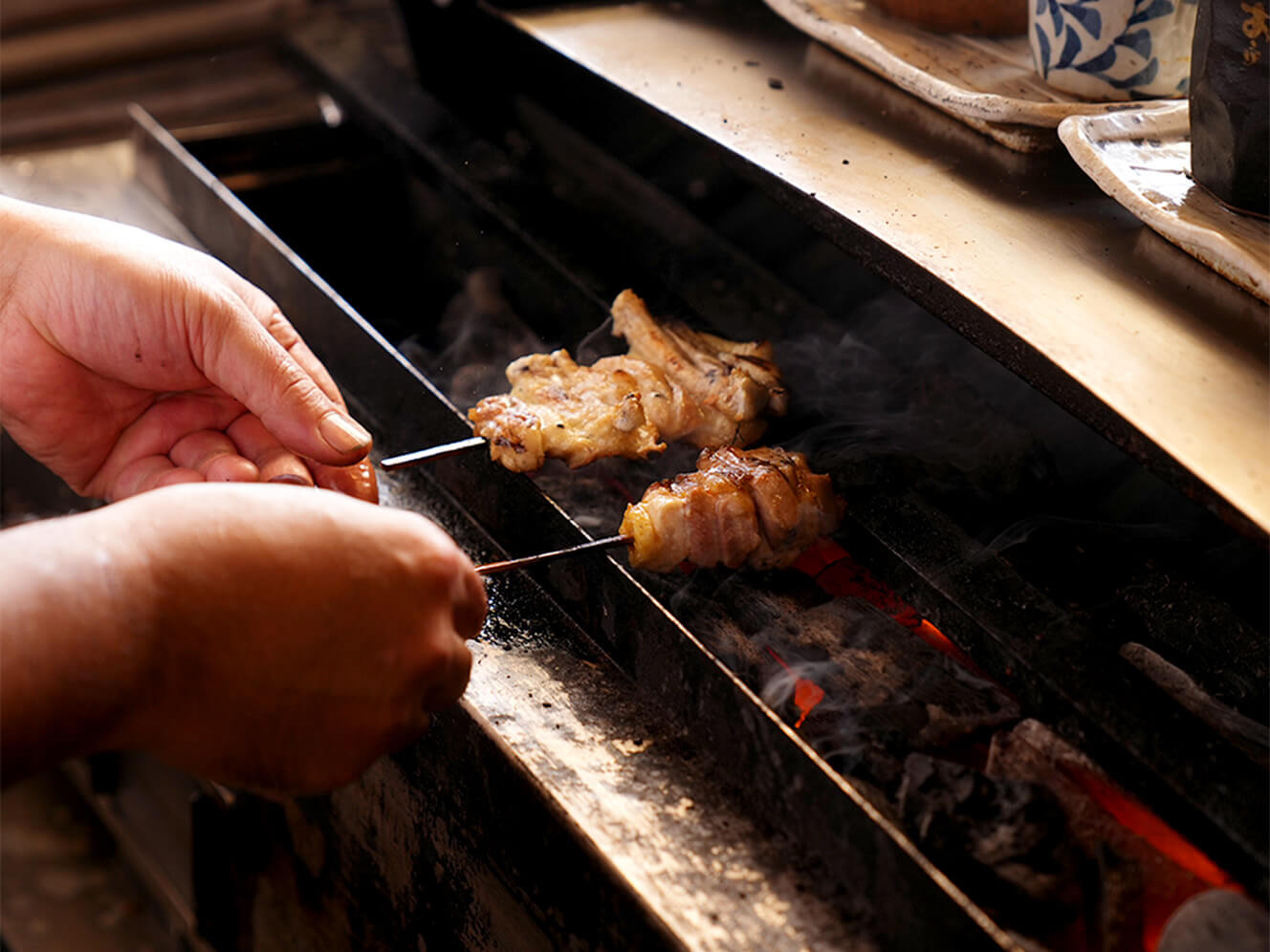
Chapter 09
Towards the next generation
of yakitori chefs.
“I want to make my own restaurant someday.” To make this dream come true, you must improve not only our skills but also your skills in courtesy and customer service. With such an increase in the number of yakitori restaurants, that is the key to becoming the restaurant of choice for customers. Now, I am teaching my young employees by giving them hands-on experience in the field and devoting myself to practice so that I can set an example for them. Although the training process is difficult and demanding at first, one is able to see what is happening in the real world on a daily basis and realize the importance of it. I hope that when my apprentices become independent in the future, they will create restaurants of value, becoming the most beloved restaurants in their communities.
I believe that grilling yakitori should be a “job” rather than mere “work.” Work is just a means to do a job, and it is just a process of making things. For example, if I make drinking glass, my work is to enrich the heart of the person who buys it by making him or her feel “value” when using it. Yakitori is not just about grilling. If it brings a smile to the face of the person who eats it, or if it is burned into their mind that the yakitori was delicious, that is the first step in the process of creating a job. When a customer wants to come back, that is when I have done my job.
When I started out on the path of yakitori, I underestimated it. Eventually, I was drawn in by its charms, and I am now pursuing a higher caliber as a artisan. My current goal is to “improve the status of yakitori artisans,” which is a goal with much hardship. The more I do it, the more I have to pursue the essence of craftsmanship, and of course I have to discipline myself in various ways. Although these challenges are both enjoyable and painful, I feel a sense of mission to convey to the next generation who want to become yakitori chefs that “being a craftsman is wonderful and there is a dream for the future.”
I believe that the right answer is to choose the path of yakitori that is loved by the masses in a cheerful, old-fashioned way… The interesting thing about this world is that there are many different paths, and there is more than one way to enter. First of all, you have to consider whether there is room for growth when you decide to become a professional in that field. In our case, there is no such thing as “staying put.” It is an interesting test toward ourselves to see how far we can go in doing something universal. It is also rewarding for an artisan to be able to express themselves differently the harder they work, so I think it is fine for each person’s way of life to manifest in different ways when preparing yakitori.
Chapter 10
We will continue
to live by the motto,
“One skewer,
one lifetime.”
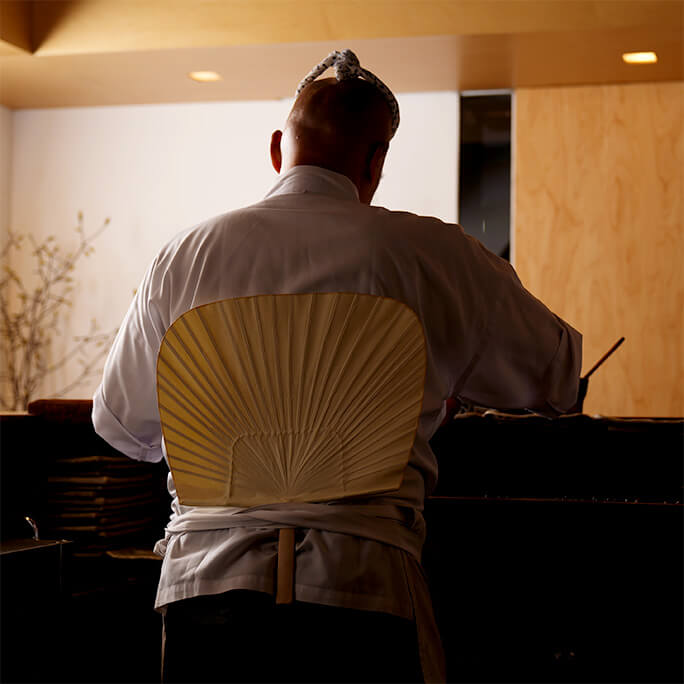
I decided to pursue yakitori as a craftsman because I thought it was something so profound that I would never be able to reach an answer explaining “the enjoyment of confronting the chicken,” “the enjoyment of thinking about a single skewer,” or “the enjoyment of manipulating the fire of the charcoal.” Recently, the number of high quality, authentic yakitori restaurants has been increasing, and the trend is gradually building nationwide. The number of young people who want to operate yakitori restaurants is increasing, and I feel that the situation is really changing. Now is the time for Japanese yakitori to move on to the next stage. I believe it has a lot of potential, so I am sure it will spread further around the world and become “more beloved food” in the future.
It is difficult to say in a few words what the orthodox way of yakitori is, but I believe that as we pursue this road, various changes will emerge. In any industry, over time, what was once known as the “orthodox” is sometimes abandoned and a new path emerges. Even long-established businesses that have been around for over 100 years are actually undergoing dramatic changes in hidden places. I like the fact that even if the appearance doesn’t change, they are challenging new things on the inside. If you just keep the same taste, you will decline, so I would like to keep changing myself, seeking new possibilities through various encounters.
I am very interested in hearing about people using different ingredients in different dishes, so I actively communicate with them and learn from them. My apprentices are growing up rapidly, and now we are in the stage of laying the foundation for the location and other aspects of the business. In order to expand the potential of yakitori artisans, I will join forces with other artisans and like-minded people. We will also work to connect Japan’s food culture to a future of dreams.
No matter how much the world of yakitori may change, the important basics that we have inherited from our predecessors cannot and will not change. I want to continue yakitori even as I get older and reach the age of 80 or 90. I believe that I can expand the world beyond tradition. As for my work, being able to grill yakitori in the first place, and being able to serve it directly to customers is the pride of a craftsman and a way of life. Nothing is as perfect as something simple, and I apologize to my customers, but I have yet to create a skewer that I am truly satisfied with. Even now, I am limited by barriers and often worry, but I will continue on this path, believing that “this one skewer is a job worth pursuing for the rest of my life.”
Chapter 11
Conclusion
More than 20 years ago, when I was working at Toriyoshi in Nakameguro, EXILE leader HIRO and other members of EXILE visited the restaurant, drinking lemon sours, eating yakitori, and discussing their dreams.
Since then, those people who were talking about their dreams over yakitori have made their dreams come true, energizing Japan and making many people smile nationwide.
EXILE’s company, LDH, continues to grow and expand its challenges to the world. What is the driving force behind this?
I was curious to find out, and found that not only EXILE, but also EXILETRIBE, EXPG school for boys and girls, and VOCALBATTLEAUDITION, which has given opportunities to young people all over Japan, are the foundation of LDH’s belief in the power of dreams and its continuous creation of “a system to challenge dreams”.
Just as Mr. Hiro established EXILE by transforming dancers into “performers,” if we can master the art of yakitori and raise the status of artisans together with like-minded people…. I would like to create an LDH-like system in the world of yakitori in order to inherit and evolve the traditional technique and continue to develop it as part of Japan’s food culture. This dream grew inside of me.
If I worked hard, would my dream come true?
Once again, an encounter that I had never imagined came my way. I am now excited to take on new challenges together with LDH toward the future of yakitori. I am sure that I will be just like the young EXILE members who were passionately talking about their dreams at Toriyoshi.
Yakitori Artisan Yoshiteru Ikegawa
Yoshiteru Ikegawa and LDH will co-create a new project.


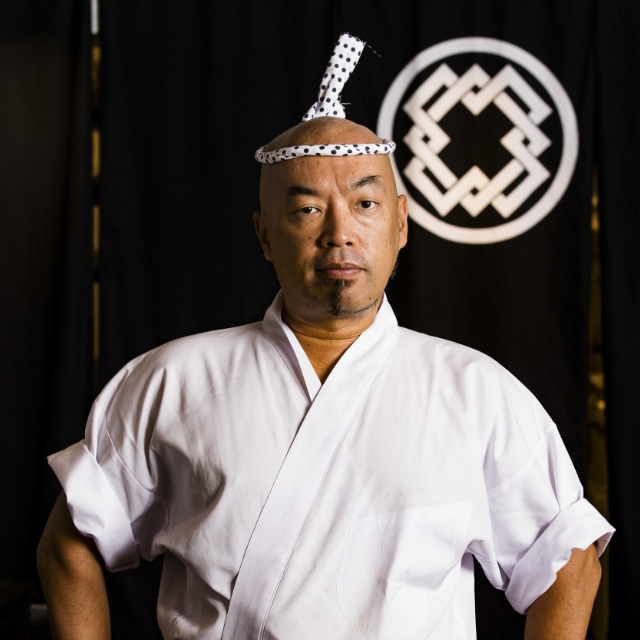
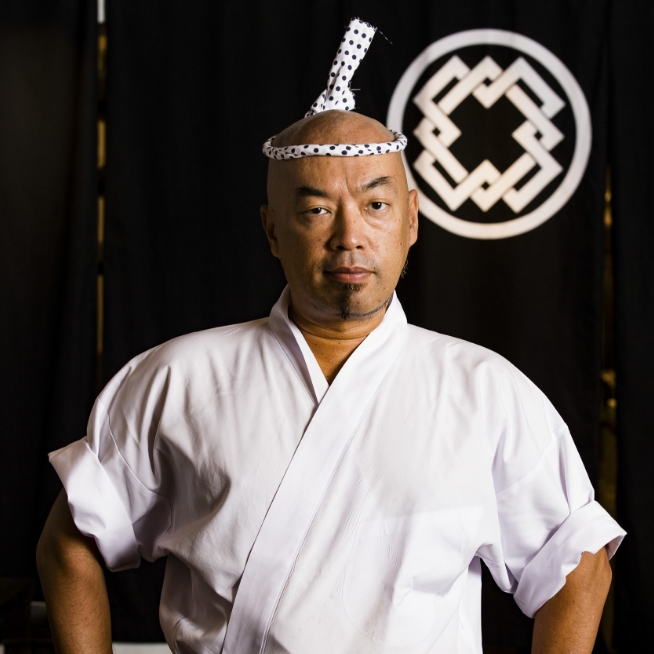

 Index
Index